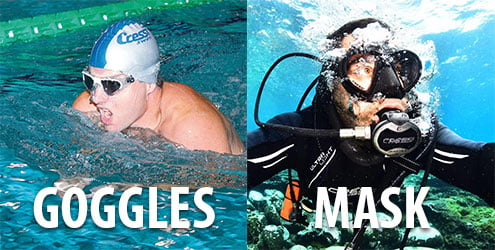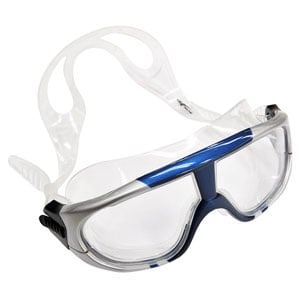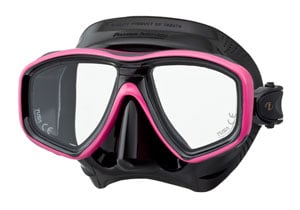Goggles vs Masks

We need to get some clarification here — there is no such thing as a diving or snorkelling goggle. Goggles are used for skiing, swimming and sometimes flying and they are also used as safety eye wear in various work applications. They are not used for scuba diving, freediving, spearfishing or snorkelling — masks are.
The dictionary defines goggles as, "Large spectacles equipped with special lenses having protective rims to prevent injury to the eyes from water, strong wind, flying objects, blinding light and even flying objects." Though water is mentioned, the goggles meant by that definition are Swimming Goggles.
 The swim goggle is designed to seal against the inner or outer areas of the eye sockets only, whereas diving and snorkelling masks include the wearer's nose. A swimmer may use a mask, but a diver or snorkeller may not use swim goggles. Though it may sound unfair, there is a very good reason for this distinction.
The swim goggle is designed to seal against the inner or outer areas of the eye sockets only, whereas diving and snorkelling masks include the wearer's nose. A swimmer may use a mask, but a diver or snorkeller may not use swim goggles. Though it may sound unfair, there is a very good reason for this distinction.
When dealing with snorkelling, skin diving or scuba diving, Boyle's law of physics regarding pressure affects on air spaces is in play. We won't confuse you with the mathematics and physics behind it, but would rather explain it with what actually happens if swim goggles are used for these applications.
When we talk about pressure, in reality we are talking about weight. When you apply pressure to an object you are applying weight. If the object that the pressure is being applied to is compressible, it will compress. This is true of air when water pressure is applied to it. Water is 800 times denser than air and when we go underwater in this denser environment, the weight of the water is going to affect the air spaces in both the goggles and the mask. The deeper we go, the more weight (pressure) the water will place on these air spaces.
The effect is that the goggles and masks are pushed tighter to the face. This phenomenon is called a 'squeeze' which can run anywhere to mild discomfort to outright pain. An analogy would be the difference between a gentle hug and a bear hug.
Now we've said this pressure affects both, but we haven't really given any concrete reason as to why goggles are not to be used when snorkelling. Or have we?
 Before you stick your nose up in the air and pooh-pooh at what has already been said, we do want to point out that the reason was indirectly alluded to in the third paragraph of this article. We could let you sniff around for it, or call out the bloodhounds to find the relationship but we will, instead, point your nose in the right direction.
Before you stick your nose up in the air and pooh-pooh at what has already been said, we do want to point out that the reason was indirectly alluded to in the third paragraph of this article. We could let you sniff around for it, or call out the bloodhounds to find the relationship but we will, instead, point your nose in the right direction.
It is the fact that masks both enclose the nose whereas the goggles do not. Having the nose enclosed allows skin divers the ability to add air into the mask to equalise this pressure. Adding air by simply exhaling a bit through your nose will alleviate the discomfort.
Now we must admit that the squeeze will only affect skin divers (also called breath hold divers, apnea divers, or freedivers) and not those who choose to remain solely at the surface (snorkellers). The reason for this instance is based again on the nose being enclosed with the mask.
Snorkellers, use a snorkel. This allows them to breathe while having their face submerged. It also keeps them from having to constantly lift their face out of the water to get another breath of air. Having the nose enclosed is a great reminder to inhale through the mouth rather than the nose.
Now go out and impress all of your friends with this new-found knowledge and help spread the word far and wide. Shout it from the mountaintops and from sea to shining sea. GOGGLES ARE FOR SWIMMING (wait for echo) NOT FOR DIVING OR SNORKELLING!
For a large range of Goggles and Masks for various applications and conditions from the The Scuba Doctor Dive Shop, please visit:

